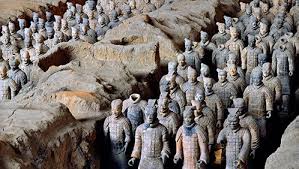
Were the Terracotta Warriors Made by Burning Live People?
The Terracotta Army, standing guard over the tomb of China's First Emperor Qin Shi Huang, is a breathtaking spectacle. The sheer scale and detail of these life-sized warriors captivate visitors from around the world. However, a persistent myth suggests a gruesome origin for these clay soldiers: that they were made by burning live people. This article will debunk this myth and explore the true artistry and craftsmanship behind their creation.
The Myth of Live Burial
The idea that the Terracotta Army involved live burial likely stems from a few factors:
- The Sheer Number and Lifelike Quality: The army's size, with over 8,000 figures, each uniquely detailed, might seem unfathomable without resorting to unimaginable practices.
- Ancient Chinese Burial Practices: While it's true that human sacrifice was practiced in ancient China, particularly during the Shang Dynasty, it was largely abandoned by the Qin Dynasty.
- Rumors and Misinterpretations: Over time, whispers and exaggerations surrounding the Terracotta Army's creation likely morphed into the myth of live burial.
Debunking the Myth with Evidence
Several pieces of evidence refute the claim of live burials:
- No Human Remains: Extensive archaeological excavations have never found any human remains within the pits housing the Terracotta Army. This absence of skeletal evidence directly contradicts the live burial theory.
- The Firing Process: The warriors were crafted from terracotta clay, a material that requires firing at extremely high temperatures (around 1,000 degrees Celsius) to harden. Encasing a living person in clay and subjecting them to such heat would be impossible and leave behind undeniable forensic evidence.
- Individualized Features: Each warrior boasts unique facial features, hairstyles, and expressions. This meticulous attention to detail points to the work of skilled artisans, not a process involving live models.
The Real Story: Master Craftsmanship and Artistic Genius
The creation of the Terracotta Army is a testament to the ingenuity and skill of Qin Dynasty artisans. Here's how they were made:
- Modular Construction: The figures were made using a combination of molds and hand-carving. Body parts like legs and torsos were created using molds for consistency, while heads, hands, and details were sculpted individually.
- Assembly and Firing: Once the clay components were sculpted, they were assembled and any seams smoothed over. The figures were then fired in kilns, hardening the clay and giving them their characteristic reddish-brown hue.
- Painting and Detailing: After firing, the warriors were meticulously painted in vibrant colors, many of which have since faded over time. Weapons and armor were added, further enhancing their realism.
The Terracotta Army: A Legacy of Art and Ingenuity
The Terracotta Army is not a monument to cruelty, but a testament to human ingenuity, artistic mastery, and the organizational prowess of the Qin Dynasty. These clay soldiers, standing silent for centuries, speak volumes about the skills of ancient Chinese artisans and their ability to immortalize an emperor's ambition in clay.
Q&A
1. Why were the Terracotta Warriors created?
The Terracotta Army was built to accompany Qin Shi Huang, the first emperor of China, in the afterlife. They served as a symbolic army, protecting him and showcasing his power in the afterlife.
2. How long did it take to create the Terracotta Army?
It's estimated that it took approximately 40 years and the labor of around 700,000 workers to create the vast Terracotta Army.
3. Were the Terracotta Warriors originally painted?
Yes, the Terracotta Warriors were originally painted in vibrant colors, including reds, blues, greens, and yellows. However, much of this paint has faded or flaked off over the centuries due to exposure to the elements.